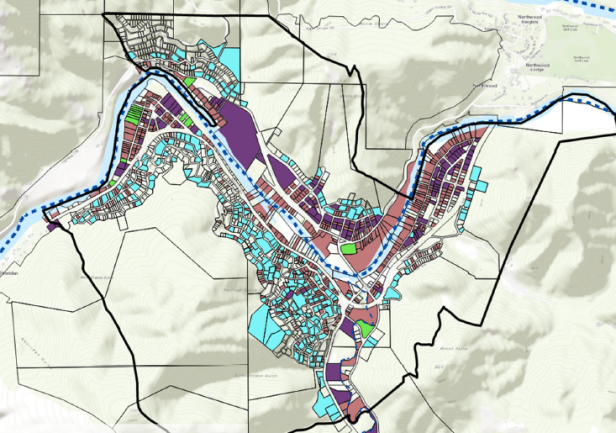 photo credit: photo credit text goes here
photo credit: photo credit text goes hereBrelje & Race submitted this drawing of Monte Rio and Villa Grande
properties and various wastewater treatment system types as part of its
presentation to the Lower Russian River Wastewater Citizens Advisory
Group meeting Oct. 24.
Seats at the Monte Rio Community Center were full Thursday night for what residents thought was the final step before county supervisors forced them into an unpopular and expensive plan to replace their septic systems.
Clarity only came late in the meeting, when Deputy County Administrator Barbara Lee attempted to calm frustrated residents.
Until then, the prevailing assumption was the Sonoma County board of supervisors would decide in January whether every household in Monte Rio and Villa Grande had to connect to a new sewer line or create community leach fields, all at a cost of tens of thousands of dollars per home.
“This isn't the county saying, ‘Oh, you guys are going to have to do something,” Lee said. “The county is trying to say, ‘Okay, it looks like you guys are going to have to do something to comply with the state requirements. Let's try to find some options, and let's try to find some ways to bring federal money in to help everybody do this.’”
Those state requirements fall under California’s new Onsite Wastewater Treatment System Policy, which sets minimum standards for every septic system in the state.
As of August, these standards apply to all new septic systems installed in the county. Any system operating now isn’t subject to the requirements, but any new system will be.
Which begs the question:
What will Monte Rio and Villa Grande residents do when their septic systems stop working?
In other neighborhoods, the answer is simple: replace them.
But out on the lower Russian River, it’s not that straightforward. Even if residents had the $100,000 or more to pay for the new technology — and many don’t — their property might not support a new system because their lot is too short, too narrow, or too steep.
Which is where the consulting civil engineers came in. The county hired Brelje & Race to prepare wastewater system alternatives for Monte Rio and Villa Grande: the two plans residents voiced their opinions over Thursday night.
One option would install up-to-standard septic tanks and group neighboring properties into shared leach fields positioned in the hills. The costs could run as high as $90,000 per household, although county staff anticipated grants would cover a portion.
The second option would tie Monte Rio and Villa Grande into a new sewer system with pressurized lines connected to the Guerneville treatment plant. This plan would be more expensive, but county leaders say federal grant money exists to pick up the full tab for residents, leaving them with a monthly operating fee.
Residents say they are concerned about how both plans would operate during floods or extended power outages. But they also say the sewer plan has a catch: the Guernville treatment plant needs an estimated $45 million overhaul, even without taking on any new wastewater. That’s according to the engineers’ report.
Hanne Jensen is a Monte Rio resident who grew up in Denmark and touts the virtue of a municipal system. But she says she isn’t sold on the sewer plan.
“We would love to go with that solution, but until that is fixed — and they have been talking about getting it fixed for so many years — we don't really trust that it's going to get fixed,” Jensen said.
Lower Russian River Wastewater Community Advisory Group member Dan Fein says he agrees with Jensen. But still thinks the sewer option deserves more attention.
“And everybody who says we shouldn't go there until it's fixed is right, but that doesn't mean you don't plan to go there ever, right? So, you know, I don't think that that's an argument to not do it,” Fein said.
Monte Rio resident Deirdre Golani says she sees Fein’s point, but has concerns about the ongoing costs.
“I would love to join the Guerneville sewage treatment plant, I think that makes the most sense long term but my god they’ve got to fix it,” Golani said. “And then I think people would be willing to join it. And I also think it's incredibly expensive. If they're estimating 200 a month, that's really a lot of money for people on limited incomes.”
But that argument — about finances — is exactly why some, including Sonoma County’s director of community initiatives Ché Casul, prefer the sewer system and the federal grants it can draw.
“You're going to have to replace your septic at some point — or you could get a free connection to a sewer system that, yes, there's going to be problems, that it's going to be years in the making. But we know that if you're connected to sewer, your property value goes up. It's going to be paid for, and it's going to be a system that is impervious to the whims of the state and the water board,” Casul said.
It’s a point that lands with Monte Rio resident Krista Odden.
“Near the very end of the meeting, understanding that for people who will not be able to like, no matter how much money they have, their lots, will not be able to comply with new state regulations around septic, and so what is going to happen to those homes and those people if we don't come up with another decision? And everyone in this room is like, ‘Don't touch my septic. It's working,’ and ‘I don't want to pay all this money,’” Odden said. “I work from home, I live here. I do not want to listen to construction for years, but with that understanding about these changes in the state regulations, it does change to kind of, ‘We have to do something.’ And I feel more strongly about that now.”
As for Dan Fein — the volunteer on the Community Advisory Group — he says he’s felt strongly about it for at least fourteen years.
“In 2010 I was a member of another group that was looking at this and we put out a report, and the last line of the report says, 'The status quo is not sustainable,'" Fein said.

 Live Radio
Live Radio




